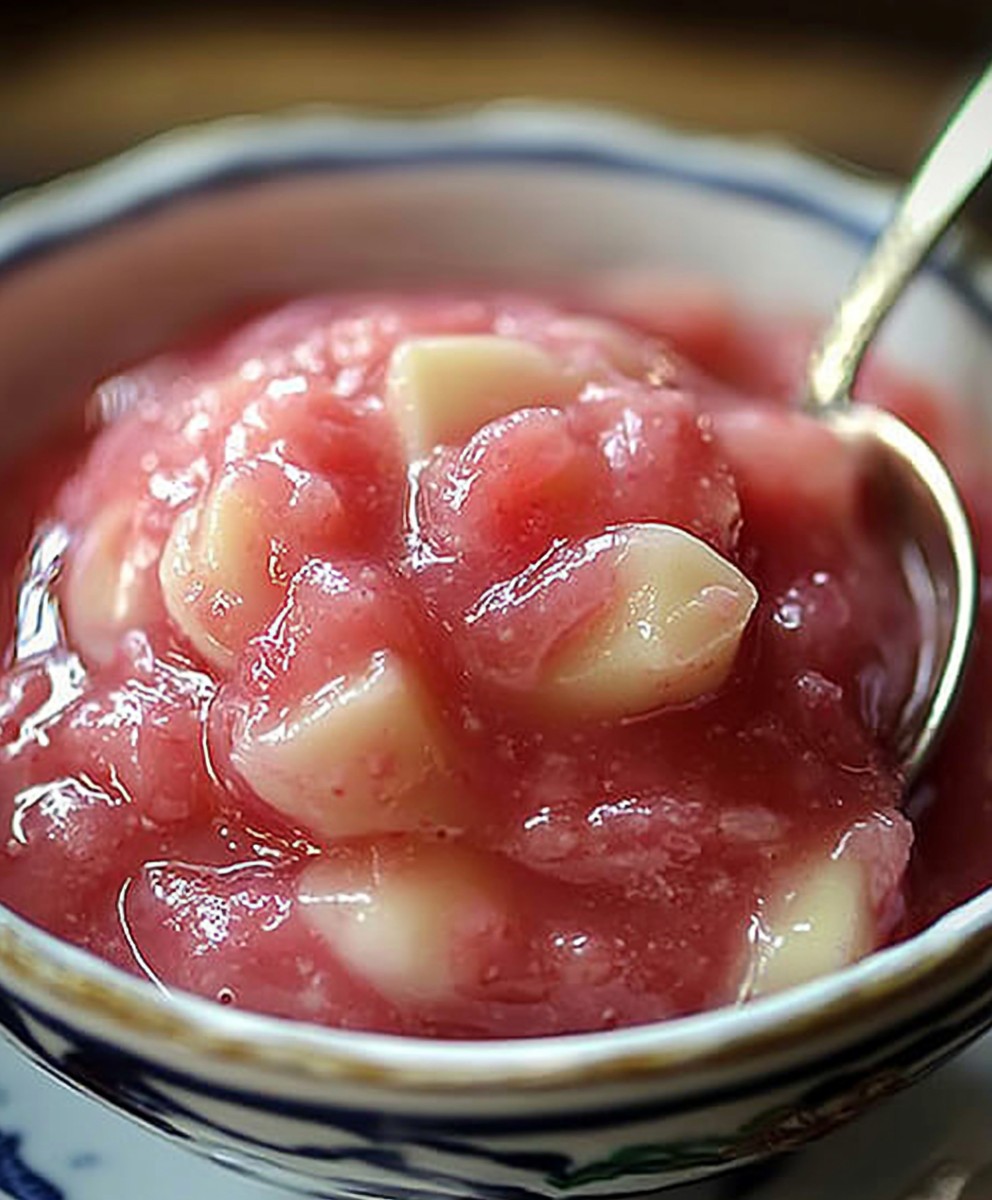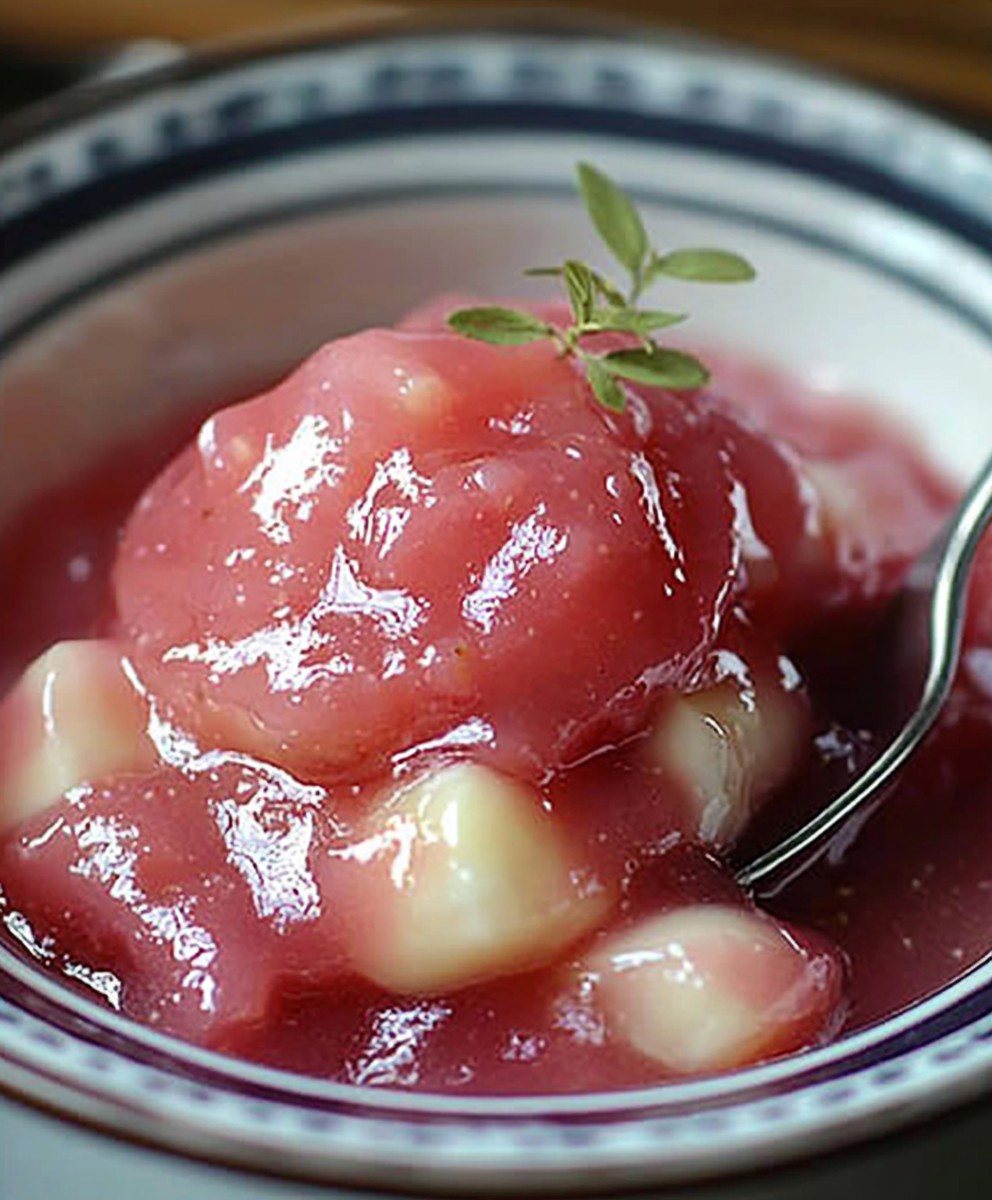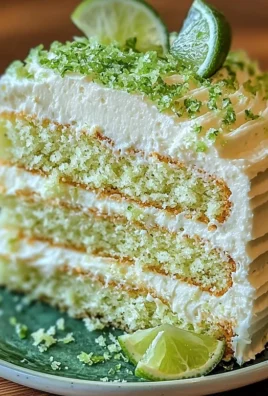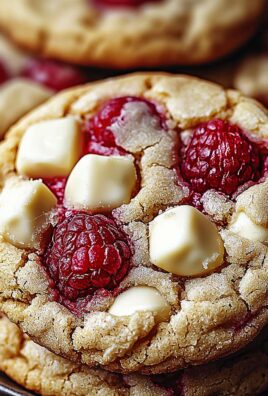Rhubarb sauce, that vibrant, tangy-sweet condiment, is about to become your new favorite way to brighten up any meal! Imagine a spoonful of glistening, ruby-red sauce cascading over creamy vanilla ice cream, or perhaps drizzled atop a perfectly grilled pork chop. Are you intrigued yet? I hope so, because this recipe is a game-changer.
While rhubarb is often mistaken for a fruit, it’s actually a vegetable, and its culinary history is surprisingly fascinating. Originating in Asia, rhubarb made its way to Europe and eventually to North America, where it quickly became a springtime staple. For generations, families have eagerly awaited the first rhubarb stalks of the season, transforming them into pies, crumbles, and, of course, our star of the show: rhubarb sauce.
But what makes this sauce so irresistible? It’s the perfect balance of tartness and sweetness, a flavor profile that awakens the palate and complements a wide range of dishes. The slightly jammy texture is incredibly satisfying, and the vibrant color adds a touch of elegance to any plate. Plus, it’s incredibly easy to make! Whether you’re a seasoned chef or a kitchen novice, you’ll find this recipe straightforward and rewarding. Get ready to discover the magic of rhubarb!
Ingredients:
- 1.5 lbs fresh rhubarb, trimmed and cut into 1-inch pieces
- 1 cup granulated sugar (adjust to taste depending on rhubarb tartness)
- 1/2 cup water
- 1 tablespoon lemon juice (freshly squeezed is best!)
- 1 teaspoon vanilla extract
- 1/4 teaspoon ground cinnamon (optional, but adds a lovely warmth)
- Pinch of salt
- 1 tablespoon cornstarch (for thickening, optional)
- 2 tablespoons cold water (for cornstarch slurry, optional)
Preparing the Rhubarb:
First things first, let’s get that rhubarb ready! You’ll want to start by giving it a good rinse under cold water. Rhubarb can sometimes have a bit of dirt clinging to it, so make sure you get it all off.
Next, trim off the leaves. Important: Rhubarb leaves are poisonous and should never be eaten! Discard them safely. Then, trim off the very bottom of the stalk, where it was cut from the plant.
Now, chop the rhubarb into 1-inch pieces. This size is perfect because it allows the rhubarb to break down nicely during cooking without completely disappearing. Uniformity in size also helps ensure even cooking.
Cooking the Rhubarb Sauce:
-
Combine Ingredients: In a medium-sized saucepan, combine the chopped rhubarb, granulated sugar, water, lemon juice, vanilla extract, cinnamon (if using), and a pinch of salt. Give everything a good stir to make sure the sugar is evenly distributed.
-
Bring to a Simmer: Place the saucepan over medium heat and bring the mixture to a simmer. You’ll start to see bubbles forming around the edges of the pan. Be patient; this might take a few minutes.
-
Simmer and Stir: Once simmering, reduce the heat to low, cover the saucepan, and let the rhubarb cook for about 10-15 minutes, or until it’s softened and starting to break down. Stir occasionally to prevent sticking and to help the rhubarb cook evenly. The rhubarb should be easily pierced with a fork when it’s ready.
Important Note: The cooking time will depend on the thickness of your rhubarb stalks and how finely you chopped them. Keep an eye on it and adjust the cooking time as needed.
-
Check for Consistency: After about 10 minutes, check the consistency of the sauce. It should be slightly thickened, but still a bit watery. If you prefer a thicker sauce, proceed to the next step. If you’re happy with the consistency, you can skip the cornstarch slurry.
-
Thickening the Sauce (Optional): If you want a thicker sauce, now’s the time to use the cornstarch. In a small bowl, whisk together the cornstarch and cold water until smooth. This creates a slurry that will prevent the cornstarch from clumping when added to the hot sauce.
-
Add Cornstarch Slurry: Slowly pour the cornstarch slurry into the simmering rhubarb sauce, stirring constantly. Continue to stir until the sauce thickens to your desired consistency. This usually takes just a minute or two. Be careful not to add too much cornstarch, as it can make the sauce gluey. A little goes a long way!
-
Taste and Adjust: Once the sauce has thickened, taste it and adjust the sweetness as needed. If it’s too tart, add a little more sugar, a tablespoon at a time, until it reaches your desired sweetness. You can also add a squeeze more lemon juice if you want to brighten the flavor.
-
Cool and Serve: Remove the saucepan from the heat and let the rhubarb sauce cool slightly before serving. As it cools, it will thicken up even more. You can serve it warm or cold, depending on your preference.
Serving Suggestions:
Rhubarb sauce is incredibly versatile! Here are just a few ideas on how to enjoy it:
- Over Ice Cream: A classic pairing! The tartness of the rhubarb sauce complements the sweetness of the ice cream perfectly. Vanilla, strawberry, or even ginger ice cream would be delicious.
- With Yogurt or Oatmeal: Add a spoonful of rhubarb sauce to your morning yogurt or oatmeal for a burst of flavor and a healthy start to the day.
- As a Topping for Pancakes or Waffles: Ditch the syrup and try rhubarb sauce on your pancakes or waffles. It’s a delightful and unexpected twist.
- With Roasted Meats: Rhubarb sauce can also be served as a savory accompaniment to roasted meats like pork or chicken. The tartness of the rhubarb cuts through the richness of the meat, creating a balanced and flavorful dish.
- In a Crumble or Crisp: Use rhubarb sauce as the base for a delicious crumble or crisp. Top it with a buttery oat topping and bake until golden brown.
- As a Filling for Pies or Tarts: Rhubarb sauce can be used as a filling for pies or tarts, either on its own or in combination with other fruits like strawberries or apples.
- With Cheesecake: A dollop of rhubarb sauce on top of a creamy cheesecake is a match made in heaven. The tartness of the rhubarb balances the richness of the cheesecake beautifully.
- As a Sauce for Duck: Similar to other fruit sauces, rhubarb sauce pairs wonderfully with duck. The acidity cuts through the richness of the duck, creating a balanced and flavorful dish.
Storage Instructions:
If you have any leftover rhubarb sauce (which is unlikely!), you can store it in an airtight container in the refrigerator for up to 5 days. You can also freeze it for longer storage. To freeze, let the sauce cool completely, then transfer it to a freezer-safe container or bag. It will keep in the freezer for up to 3 months. When you’re ready to use it, thaw it in the refrigerator overnight.
Tips and Variations:
- Adjust the Sweetness: The amount of sugar you need will depend on the tartness of your rhubarb. Start with 1 cup and add more to taste.
- Add Other Fruits: Rhubarb pairs well with other fruits like strawberries, raspberries, apples, and ginger. Feel free to add a cup or two of chopped fruit to the saucepan along with the rhubarb.
- Spice it Up: Experiment with different spices like ginger, cardamom, or nutmeg. A pinch of ground ginger adds a lovely warmth, while cardamom adds a more exotic flavor.
- Use Honey or Maple Syrup: Instead of granulated sugar, you can use honey or maple syrup to sweeten the sauce. This will give it a slightly different flavor profile.
- Make it Boozy: Add a splash of your favorite liqueur, like Grand Marnier or Amaretto, for an extra layer of flavor. Add it towards the end of the cooking process.
- For a Smoother Sauce: If you prefer a smoother sauce, you can use an immersion blender to puree the rhubarb after it has cooked. Be careful when blending hot liquids!
- Use Frozen Rhubarb: If fresh rhubarb isn’t available, you can use frozen rhubarb. There’s no need to thaw it before cooking. Just add it to the saucepan as is and adjust the cooking time as needed.
- Make a Large Batch: Rhubarb sauce freezes well, so feel free to make a large batch and freeze it in smaller portions for later use.
Troubleshooting:
Sauce is too thin: If your sauce is too thin, even after adding the cornstarch slurry, you can continue to simmer it over low heat until it thickens to your desired consistency. You can also add a bit more cornstarch slurry, but be careful not to add too much, as it can make the sauce gluey.
Sauce is too thick: If your sauce is too thick, add a little water, a tablespoon at a time, until it reaches your desired consistency.
Sauce is too tart: If your sauce is too tart, add a little more sugar, a tablespoon at a time, until it reaches your desired sweetness.
Sauce is too sweet: If your sauce is too sweet, add a squeeze more lemon juice to balance the flavors.
Rhubarb is still tough: If the rhubarb is still tough after the recommended cooking time, continue to simmer it over low heat until it softens. The

Conclusion:
This isn’t just another sauce recipe; it’s a gateway to a world of tart and sweet deliciousness! I truly believe this rhubarb sauce is a must-try for anyone looking to add a vibrant, homemade touch to their meals. The simplicity of the ingredients combined with the incredible flavor payoff makes it a winner in my book, and I’m confident it will be in yours too.
Think about it: the bright, tangy rhubarb, mellowed by just the right amount of sweetness, creates a symphony of flavors that dances on your tongue. It’s not overly complicated, it doesn’t require hours in the kitchen, and the result is something truly special. Forget store-bought sauces loaded with artificial ingredients; this is the real deal, made with love and bursting with natural goodness.
But the best part? The versatility! This rhubarb sauce isn’t just a one-trick pony. While it’s absolutely divine spooned over vanilla ice cream or swirled into yogurt, the possibilities are truly endless. Imagine it drizzled over grilled pork chops for a sweet and savory contrast, or used as a glaze for baked ham. It’s also fantastic as a topping for pancakes or waffles, adding a delightful twist to your breakfast routine.
And if you’re feeling adventurous, why not experiment with some variations? A pinch of ginger or cinnamon can add warmth and spice, while a splash of orange juice can enhance the citrusy notes. For a richer flavor, try adding a tablespoon of butter towards the end of cooking. You could even incorporate other fruits like strawberries or raspberries for a mixed berry rhubarb sauce that’s simply irresistible.
Here are a few more serving suggestions to get your creative juices flowing:
* Pair it with creamy cheeses: Rhubarb sauce is a surprisingly delicious accompaniment to brie, goat cheese, or even cream cheese. Serve it with crackers for an elegant appetizer.
* Use it as a filling for pastries: Imagine rhubarb sauce nestled inside flaky croissants or danishes. It’s a delightful treat that’s perfect for brunch or dessert.
* Stir it into oatmeal or porridge: Add a spoonful of rhubarb sauce to your morning oatmeal for a burst of flavor and a healthy dose of antioxidants.
* Create a rhubarb vinaigrette: Whisk together rhubarb sauce with olive oil, vinegar, and Dijon mustard for a unique and flavorful salad dressing.
* Make rhubarb parfaits: Layer rhubarb sauce with granola and yogurt for a quick and easy parfait that’s both healthy and delicious.
I’m so excited for you to try this recipe and discover the magic of homemade rhubarb sauce for yourself. It’s a simple pleasure that can elevate so many dishes, and I know you’ll love it as much as I do.
So, what are you waiting for? Gather your ingredients, put on your apron, and get ready to create something amazing. And most importantly, don’t forget to share your experience! I’d love to hear how you used this rhubarb sauce, what variations you tried, and what dishes you paired it with. Leave a comment below and let me know your thoughts. Happy cooking! I can’t wait to see what culinary masterpieces you create.
Rhubarb Sauce: The Ultimate Guide to Making Delicious Homemade Sauce
Easy homemade rhubarb sauce, perfect for topping ice cream, yogurt, pancakes, or even serving with roasted meats. Tart, sweet, and incredibly versatile!
Ingredients
- 1.5 lbs fresh rhubarb, trimmed and cut into 1-inch pieces
- 1 cup granulated sugar (adjust to taste depending on rhubarb tartness)
- 1/2 cup water
- 1 tablespoon lemon juice (freshly squeezed is best!)
- 1 teaspoon vanilla extract
- 1/4 teaspoon ground cinnamon (optional, but adds a lovely warmth)
- Pinch of salt
- 1 tablespoon cornstarch (for thickening, optional)
- 2 tablespoons cold water (for cornstarch slurry, optional)
Instructions
- Combine Ingredients: In a medium-sized saucepan, combine the chopped rhubarb, granulated sugar, water, lemon juice, vanilla extract, cinnamon (if using), and a pinch of salt. Give everything a good stir to make sure the sugar is evenly distributed.
- Bring to a Simmer: Place the saucepan over medium heat and bring the mixture to a simmer. You’ll start to see bubbles forming around the edges of the pan. Be patient; this might take a few minutes.
- Simmer and Stir: Once simmering, reduce the heat to low, cover the saucepan, and let the rhubarb cook for about 10-15 minutes, or until it’s softened and starting to break down. Stir occasionally to prevent sticking and to help the rhubarb cook evenly. The rhubarb should be easily pierced with a fork when it’s ready.
- Check for Consistency: After about 10 minutes, check the consistency of the sauce. It should be slightly thickened, but still a bit watery. If you prefer a thicker sauce, proceed to the next step. If you’re happy with the consistency, you can skip the cornstarch slurry.
- Thickening the Sauce (Optional): If you want a thicker sauce, now’s the time to use the cornstarch. In a small bowl, whisk together the cornstarch and cold water until smooth. This creates a slurry that will prevent the cornstarch from clumping when added to the hot sauce.
- Add Cornstarch Slurry: Slowly pour the cornstarch slurry into the simmering rhubarb sauce, stirring constantly. Continue to stir until the sauce thickens to your desired consistency. This usually takes just a minute or two. Be careful not to add too much cornstarch, as it can make the sauce gluey. A little goes a long way!
- Taste and Adjust: Once the sauce has thickened, taste it and adjust the sweetness as needed. If it’s too tart, add a little more sugar, a tablespoon at a time, until it reaches your desired sweetness. You can also add a squeeze more lemon juice if you want to brighten the flavor.
- Cool and Serve: Remove the saucepan from the heat and let the rhubarb sauce cool slightly before serving. As it cools, it will thicken up even more. You can serve it warm or cold, depending on your preference.
Notes
- Adjust the Sweetness: The amount of sugar you need will depend on the tartness of your rhubarb. Start with 1 cup and add more to taste.
- Add Other Fruits: Rhubarb pairs well with other fruits like strawberries, raspberries, apples, and ginger. Feel free to add a cup or two of chopped fruit to the saucepan along with the rhubarb.
- Spice it Up: Experiment with different spices like ginger, cardamom, or nutmeg. A pinch of ground ginger adds a lovely warmth, while cardamom adds a more exotic flavor.
- Use Honey or Maple Syrup: Instead of granulated sugar, you can use honey or maple syrup to sweeten the sauce. This will give it a slightly different flavor profile.
- Make it Boozy: Add a splash of your favorite liqueur, like Grand Marnier or Amaretto, for an extra layer of flavor. Add it towards the end of the cooking process.
- For a Smoother Sauce: If you prefer a smoother sauce, you can use an immersion blender to puree the rhubarb after it has cooked. Be careful when blending hot liquids!
- Use Frozen Rhubarb: If fresh rhubarb isn’t available, you can use frozen rhubarb. There’s no need to thaw it before cooking. Just add it to the saucepan as is and adjust the cooking time as needed.
- Make a Large Batch: Rhubarb sauce freezes well, so feel free to make a large batch and freeze it in smaller portions for later use.
- Storage: Store leftover sauce in an airtight container in the refrigerator for up to 5 days or freeze for up to 3 months.






Leave a Comment